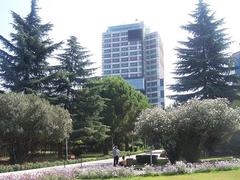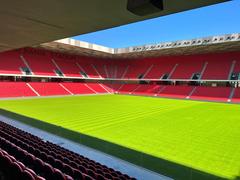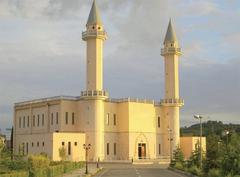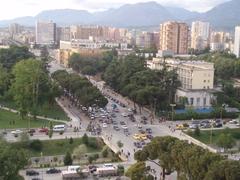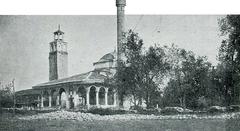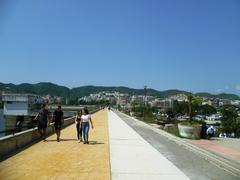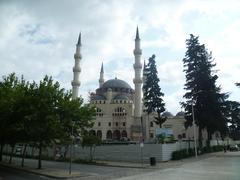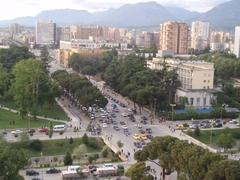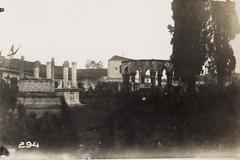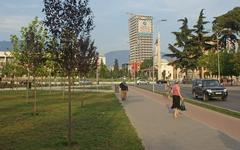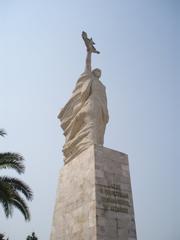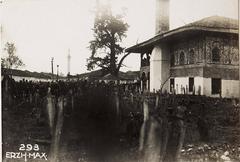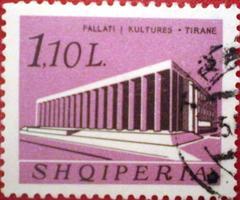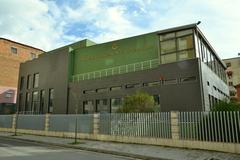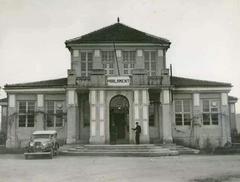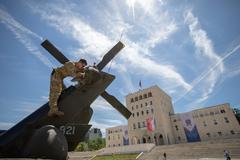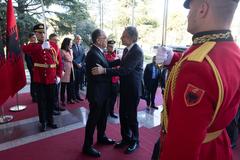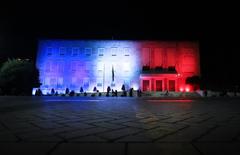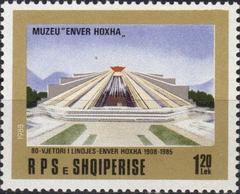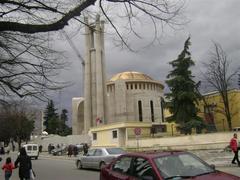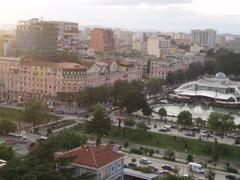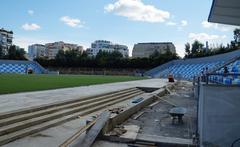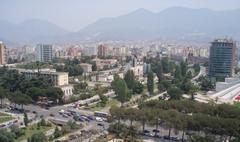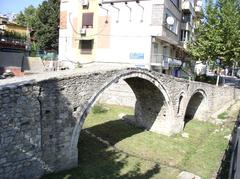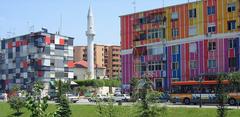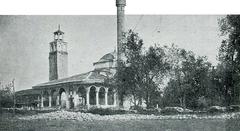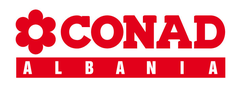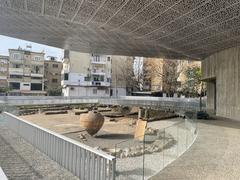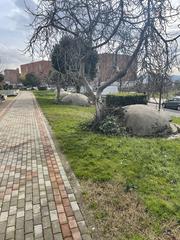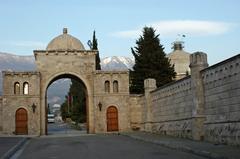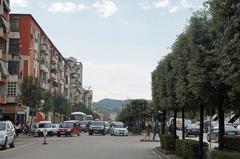National Historical Museum Tirana: Visiting Hours, Tickets, and Travel Guide
Date: 14/06/2025
Introduction
The National Historical Museum in Tirana is Albania’s largest and most important cultural institution, serving as a monumental tribute to the nation’s rich and complex history. Located at the heart of Skanderbeg Square, this grand museum has long been a central attraction for locals and visitors seeking to explore Albania’s past—from ancient Illyrians through the Communist era and into modern times. Although currently closed for a major restoration until 2028, the museum’s legacy, architectural presence, and collections continue to shape the cultural identity of Albania.
This guide offers a detailed overview of the National Historical Museum’s history, architectural features, visiting information, pavilion highlights, restoration updates, and alternative sites to explore in Tirana during the closure. For the latest updates, consult official and trusted sources (National Historical Museum Official Site; Euronews Albania; Tirana.al).
Table of Contents
- Introduction
- Historical Background & Architectural Significance
- Visitor Information
- Pavilion Highlights
- Restoration & Closure Update
- Alternative Historical & Cultural Attractions in Tirana
- Practical Tips for Visitors
- Frequently Asked Questions (FAQs)
- Visuals & Media
- Conclusion & Call to Action
- References
Historical Background & Architectural Significance
Founding & Historical Context
Officially inaugurated on October 28, 1981, the National Historical Museum (Muzeu Historik Kombëtar) was established during a pivotal era in Albania’s post-independence history. The goal was to forge a unified national identity by documenting and celebrating Albania’s multifaceted heritage—from the 4th millennium BC to the present (albaniavisit.com; tirana.al; medium.com). During the communist regime, the museum was intended as both a guardian of collective memory and an educational space, bridging generations and fostering a sense of national pride (feel-albania.com; en.wikipedia.org).
Design & Symbolism
Located centrally on Skanderbeg Square, the museum was designed by architect Enver Faja and covers 27,000 square meters, with 18,000 square meters devoted to exhibitions (humbo.com; albaniatouristguide.com; architectuul.com). Its symmetrical plan is organized around a central courtyard and multiple thematic pavilions. The most distinctive feature is the 10 x 40 meter Socialist Realism mosaic “The Albanians,” completed in 1980 by five artists (en.wikipedia.org; iett.al). This mosaic depicts pivotal figures and moments from Albanian history, symbolizing resilience and the unity of the Albanian people.
Visitor Information
Visiting Hours
Current Status: The National Historical Museum is closed for restoration from March 2024 until March 2028. Prior to closure, typical visiting hours were:
- Tuesday to Sunday: 9:00 AM – 5:00 PM
- Closed on Mondays
Check the official museum website for reopening announcements.
Ticket Prices
- Adults: 400–500 Albanian Lek (varied by season and exhibition)
- Students/Seniors: Discounted rates
- Children under 6: Free
Tickets were available for purchase at the entrance; future online purchasing options may be available upon reopening.
Accessibility
The museum has been equipped with ramps, elevators, and accessible restrooms, ensuring an inclusive experience for visitors with disabilities (humbo.com).
Guided Tours & Multimedia
Guided tours were offered in multiple languages and could be booked in advance. Multimedia displays and virtual tours enriched the visitor experience.
Travel Tips
- Allocate at least 2–3 hours for your visit.
- Combine your trip with nearby attractions like Skanderbeg Square and the Et’hem Bey Mosque.
- Arrive early to avoid crowds, especially during weekends and national holidays.
Pavilion Highlights
The museum is organized into thematic pavilions, each presenting a distinct chapter of Albanian history (Salt in Our Hair; The Crazy Tourist):
- Pavilion of Antiquity: Features 600+ artifacts from the Paleolithic to early Middle Ages, including Stone and Bronze Age tools, Illyrian jewelry, Greek and Roman relics, and the famed “Beauty of Durrës” mosaic.
- Pavilion of the Middle Ages: Showcases Albania’s transformation from Roman to Byzantine and Ottoman rule, including medieval weaponry and tributes to Skanderbeg.
- Pavilion of the Albanian National Renaissance: Documents the 19th-century independence movement through manuscripts, photographs, and memorabilia.
- Pavilion of Independence: Celebrates the 1912 declaration of independence with facsimiles, national symbols, and Ismail Qemali’s personal belongings.
- Pavilion of Iconography: Highlights Byzantine and post-Byzantine icons, church carvings, and works by Onufri.
- Pavilion of the Anti-Fascist War: Focuses on World War II resistance with uniforms, propaganda, and personal testimonies.
- Pavilion of Communist Terror: A moving exhibit on the repressive 1944–1991 regime, with prison artifacts, surveillance equipment, and personal stories (Matias Travel).
- Pavilion of Mother Teresa: Celebrates her humanitarian legacy with personal items and multimedia displays.
- Pavilion of Post-Communist Albania: Chronicles the transition to democracy with political memorabilia and contemporary artifacts.
Restoration & Closure Update
The museum closed on March 15, 2024, for a four-year restoration and modernization project aiming to upgrade its infrastructure, improve accessibility, and enhance visitor experience (Euronews Albania; Koha.net). The restoration also preserves the museum’s architectural heritage and includes the recently completed restoration of the iconic mosaic, funded by the European Union (Krista the Explorer). No temporary exhibitions or off-site displays have been announced for the duration of the closure.
Alternative Historical & Cultural Attractions in Tirana
During the museum’s closure, visitors can explore other sites that offer insights into Albania’s history (Euronews Albania; WhichMuseum):
- Bunk’Art 1 & 2: Museums in Cold War-era bunkers that detail Albania’s communist past and secret police history.
- House of Leaves: The Museum of Secret Surveillance, focusing on the Sigurimi’s activities.
- Armed Forces Museum: Displays military artifacts and uniforms.
- The Pyramid of Tirana: A unique landmark now being transformed into a youth and innovation center—climbable for panoramic views.
- Skanderbeg Square & Surroundings: Iconic landmarks, including the restored museum mosaic, Opera & Ballet Theatre, Et’hem Bey Mosque, and the Clock Tower.
- New Bazaar (Pazari i Ri): A vibrant market offering local foods and crafts.
- Tirana Castle: Remnants of the old fortress now home to shops and cafes.
Practical Tips for Visitors
- Photography: The museum’s mosaic remains visible and is a prime photo spot.
- Plan Ahead: Check opening hours and ticket details for alternative museums, as several institutions are under restoration.
- Guided Tours: Many operators now focus on open sites and outdoor heritage walks.
- Accessibility: Most alternative sites are wheelchair accessible, but confirming in advance is recommended.
Frequently Asked Questions (FAQs)
Q: When will the National Historical Museum Tirana reopen?
A: The museum is scheduled to reopen on March 15, 2028.
Q: Are there any temporary exhibitions during the closure?
A: No official temporary exhibitions or off-site displays have been announced.
Q: What were the museum’s visiting hours and ticket prices before closure?
A: 9:00 AM–5:00 PM, Tuesday to Sunday; adult tickets were typically 300–500 ALL.
Q: Is the museum accessible for visitors with disabilities?
A: Yes, before closure, the museum was fully accessible.
Q: Which alternative historical sites can I visit?
A: Bunk’Art 1 & 2, House of Leaves, Armed Forces Museum, Pyramid of Tirana, Skanderbeg Square, New Bazaar, and Tirana Castle.
Visuals & Media
Enhance your trip planning with images of:
- The National Historical Museum’s mosaic facade (alt: “National Historical Museum Tirana facade mosaic”)
- Key pavilion exhibits, such as the Beauty of Durrës mosaic and Skanderbeg artifacts
- Interiors of Bunk’Art 1 & 2 and House of Leaves (alt: “Bunk’Art 1 Cold War bunker museum” / “House of Leaves Museum of Secret Surveillance”)
- The Pyramid of Tirana (alt: “Pyramid of Tirana panoramic view”)
- Skanderbeg Square and its landmarks (alt: “Skanderbeg Square Tirana cultural center”)
Consider using interactive maps to locate these sites and virtual tour links where available.
Conclusion & Call to Action
Although the National Historical Museum Tirana is temporarily closed, Albania’s capital still offers a wealth of historical and cultural experiences. The museum’s restoration promises a renewed and enhanced visitor experience upon reopening in 2028. In the meantime, explore Tirana’s alternative museums and landmarks to enrich your understanding of Albania’s vibrant history.
For the latest news on the museum’s progress, check official updates and trusted news sources. Download the Audiala app for curated tours, up-to-date museum information, and personalized tips for exploring Tirana and beyond. Follow us on social media and browse our related posts for more insights into Albanian culture.
References and Further Reading
- National Historical Museum Official Site
- Euronews Albania
- Tirana.al
- albaniavisit.com
- medium.com
- feel-albania.com
- en.wikipedia.org
- humbo.com
- albaniatouristguide.com
- architectuul.com
- iett.al
- Koha.net
- Krista the Explorer
- Salt in Our Hair
- The Crazy Tourist
- Matias Travel
- WhichMuseum
